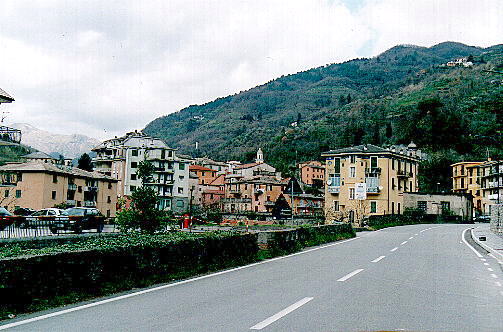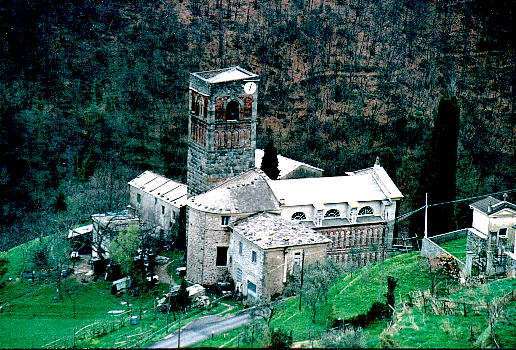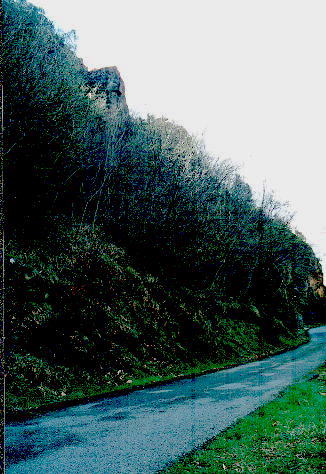In the inside mountains of oriental Liguria there is the greatest paleolithic rock sculpture of Europe, and probably the largest of the world. This great sculpture is known like the " megalithic Face of Borzone ", and exactly represents a human face, measuring approximately 7 meters height and 4 meters width.
It is located at Borzonasca (Province of Genova, Italy), a little up from the Borzone Fraction, in a place named Rocche di Borzone, i.e it is at top of the mounts.

1) site of "Parco naturale regionale dell'Aveto", that says : " the territory of the Park has been attended from the man from the prehistory.
The traces left are numerous: beginning from the so-called " Face of Christ ", enigmatic figure carved in the cliff on the Rocca di Borzone ".
2) web site" "Turismo Itinerari autostradali insoliti per non vedere sempre le solite cose", saying: " Liguria A 12 Genova-Livorno Exit Lavagna , then towards Carasco, Borgonovo and Borzonasca. Through the Passo of the Rocche for one kilometer in all. To the abbey of Borzone (...) until Rocche locality.
Here, a carved singular monument in the cliff is found: a human face of seven meters for four, framed from hairs and with a sort of hat. Unknown the age ". Then it is remembered that also on the jambs of the doors in the homes near the abbey they are looked at some stone heads :"Perhaps a sum of customs of various ages, a compound between the Roman cult of the Lari and the celtic use to stump the heads of the enemies conquered in order to decorate, also to scaramantic scope, the doors of the houses. The use of these lithic heads is found also in other old homes in Piemonte and Liguria ".
I add that the representation of head of men and animals, also two-faced, is present in lithic capitels of the same age, in the churches of all Europe, and that this type of representation has roots in the most ancient prehistory.
3) the site "Genovagando, agosto 1995", " the path of the Monks " from Borzonasca to the Abbey of Borzone, to the megalithic Face and to Zolezzi ".
4) Il sito Notiziario Turismo Liguria (ANSA) del 20/6/2000 Itinerari/ Nel Parco dell'Aveto tra i relitti glaciali, that says : " the park and all the valleys of the zone are rich also of testimonies of the presence of the man, of which some traces back to the prehistory have been found . Between the more recent signs there is the so-called " Face of Christ ", enigmatic figure carved in the cliff on the Rocca di Borzone ".
5) the site The Museum of the Origins of Man, (whose director is the writer) is the only site publishing also the photographies of the megalithic Face of Borzone and of the zone.
The megalithic Face of Borzone is in a forest of plants growing fastly. During last june the Mayor of Borzonasca Mr.Giuseppino Maschio has made to execute a substantial cleaning of the place (i.e. a cut of shrubs and trees), so the great sculpture can be seen well, good signed.The photos that I introduce here are the same ones that can be seen in the web site of the Museum of the Origins of Man. .
"The great human face of the Rocche di Borzone was discovered in 1965, January by Mr.Armando Giuliani, city council member of the comune of Borzonasca, during the overview for the construction of the road. The new came published from the genois news- paper "Corriere Mercantile", February , 1 1965 by Mr. Luigi Solari. He reported that at Borzone the inhabitants thought that the colossal face was worked by the monks living in the near abbey .

I love the legends, as I loved fables when I was child. In the legends, in fact, there are often truth and cues in order to make search. But in this case, I am confused, and I will be grateful to who will give to me an explanation: how it is possible that a detailed legend exists therefore, when " the gigantic sculpture came swallowed from the vegetation and forgotten " from some centuries! Much more that it is an historically reliable legend .
In 1975, I and some friends archeologists, we knew the discovery of the megalithic Face of Borzone, from the source then defined " Great face of Christ ", then we are gone back to the new on the Corriere Mercantile (1965) with more details. Our interpretation has been immediate, that is, a passage of attribution from historical times (work of Monks) to the prehistoric times (than then to many people seemed a hazard); in fact when we have gone on place, we have immediately seen that it could not be a recent work, also of some centuries ago. Entering in the merit of the scientific interpretation, here shortly some points about this work in the current cultural context:
1) There are 35 years that all the people interested in the megalithic Face of Borzone have seen in it a human face, as human work, even if, not being specialized, they have not been able to give a cultural attribution (datation); but recently the most has considered it prehistoric. But, it must be prehistoric, as in Europe, in historical times, sculpture techniques of working were much more evoluted, and with different subject of cult.
2) the position of official science (that in the international conferences has the most of the scholars in agreement) is not still pronounced on the rock paleolithic sculpture , as scholars have not proposed it. For this reason the paleolithic rock sculpture is absent in the books of prehistoric art with scholastic diffusion.
3) megaliths the most knew are menhir and dolmen, and are great stones erected and planted in the land. Some menhir (Carnac, France) are enormous. Some of these are anthropomorphic like the megalithic Face of Borzone. Menhir, except rarest cases, are carved for giving a harmonious shape, or they are zoomorphic or anthropomorphic . In the three cases it is matter of art applied to the monument having purpose of cult. Menhir and dolmen, in western Europe, generally are dated from the III to the II millennium B.C. The menhir of this period are generally great stones outlined and lengthened with harmonious shape. Anthropomorphous Menhir , instead, are ancient, and some are paleolithic, that is beyond 12,000 years old, and this is the opinion of the archeologists following the anthropomorphous method. The working technique of the menhir is the same one used for the paleolithic rock sculpture, as megalithic Face of Borzone
4) anthropomorphic menhir and anthropomorhic rock sculpture have the same subjects of cult that are identified with the men who have produced them , following in the time: Homo sapiens arcaic, Neanderthalians, Homo sapiens sapiens.
In short, where there were the cliffs, the cliffs were carved, where there were not, the man had to fatigue more, having to extract the stones from the land, or carry them in the cult places, but the final result was the same.
5) the megalithiy Face of Borzone is attributed to the Upper Paleolithic (approximately from 20,000 to 12,000 years ago), as many great menhir anthropomorphic at Carnac .
6) In the Upper Paleolithic in Europe we find various civilizations much different from zone to zone, but the two more important are: that one of the sculptors of the stone, having cult subjects anthropomorphic, who did not know painting; and that one of the painters with zoomorphic subjects, painting in the caves of France, Spain, etc , who don't sculpt stone. The descendants of people with sculpture have founded the cities, invented agriculture, breeding of the cattle, fusion of metals, etc. The descendants of the people with painting have dispersed themselves for the world living only of hunting and degenerating: Bushmen in Africa, Aborigenals in Australia, etc .
7) Civilizations of the sculptors had lithic tools more beautiful than those of the painters civilization . However, was equal the function to the aims of the daily use. To say that the painting is better than the sculpture is an error. However the colors of the paintings and the images, to the observer of today, generally like more. In common these two civilizations had the dimension of the works, in fact, in the great caves of France and Spain, they are painted some mammals of the dimensions of the megalithic Face of Borzone. ( the Face measures meters 7 x 4, only the face; the others parts ," hairs and hat ", increase the measurement).
8) In order to interpret the meaning of the paleolithic anthropomorhic sculpture, it is necessary to make historical and etnographic parallelisms with civilizations that have still had or have anthropomorhic sculpture. Then we become aware that the megalithic Face of Borzone was nearly surely a God. What to the contrary we cannot made with the paleolithic zoomorphic cave paintings , in how much parallelisms are not historical, but protohistorical, with the extinct populations of the Sahara, and ethnographic with the Boscimans of the South Africa, or Aborigenals of Australia , where the zoomorphic representations are tied to " spirits ", and not to a God.
9) in the cited site "Turismo Itinerari autostradali insoliti per non vedere sempre le solite cose", the megalithic Face of Borzone is considered " framed from hairs and with a sort of hat ". It is a just and interesting observation . In the small anthropomorhic sculptures of the Aurignacian (Upper Paleolithic) , that now are thought in great part made by Homo sapiens neanderthalensis,it is nearly always a pointed hat (Venus of Savignano, etc.) or an hair well dressed (Venus of Willendorf, etc ). These same types of hair-dressing are found in the etnography (Africa) with mixtures of various materials.
And, always in these Venus, where they are privileged the hair-dress or the pointed hats, then it isneglected the representation of the face, the hands and the feet. However, for scientific research, a single case is not sufficient as the megalithic Face of Borzone in order to assert that it is really an hair and hat, but other rock sculpture (or also mobile) of the same typology is necessary, insamuch than the face clearly is carved, while hair and hat, it seems, but it is not sure that they are.
10) In the photography, the clear spot looked at on the left of the face is a tight and high hole from which the light from the back is filtered. This can indicate a working of contour of the sculpture, and confirms the hypothesis of the hairs framing the face. Nothing we know about the back of the megalithic Face of Borzone. An other image could be there. As other paleolithic anthropomorhic sculptures, it could be two-faced. The bifrontism is frequent during the Paleolithic. Once I wanted to visit the back of the sculpture, but it was no possible for the steepness of the mountain, the thick vegetation, and, above all, from an unexpected thunderstorm. My curiosity is increased.

12) the human type more reliable for this face is Homo sapiens sapiens. We can desume it from the high forehead, the pointed chin and the face relatively tightened. As established recently, in this phase was still present Homo sapiens neanderthalensis, cohabiting with Homo sapiens sapiens, to which he was joined culturally, also for the production of anthropomorhic sculptures, and therefore with similar spiritual and religious practices. Recently in Portugal it have been found the rests of a child who joins the two human types. As known, Homo sapiens sapiens comprises all today the humanity. In the rock sculpture and Paleolithic menhir the representations of Neanderthaliani are frequent (and previous), while those of Homo sapiens sapiens are rare. Therefore, it is possible that the megalithic Face of Borzone is one of the more recent works of the Paleolithic
13) In the anthropomorhic lithic sculpture of the Paleolithic frontal representations of the face are rare, the representations of the head all round are rarest. The anthropomorhic sculptures, in nearly the totality, are semifrontal or lateral, and from these it is easier to deduce the evolution of the man, and therefore to date the sculptures of the Paleolithic, making reference to the finds of skulls found in the world, and of which a dating has been possible with equipments not applicable to the lithic sculpture. The megalithic Face of Borzone is the only rock sculpture that I know with frontal representation of the face.
14)Who wanted to undertake a search on the protohistorical and historical divinities of Europe (Celts, Celto-Liguri, Thracians, etc.), both in the sculptures and in ceramics, where there are two-faced and thrre-faced representations, will find the God whitout beard or the bearded God, even if the bearded subjects are a little most frequent. In the paleolithic lithic sculpture the bearded subjects are rare, and nearly the totality does not have beard. However, in the sculpture of the Paleolithic there are parts of the head that do not are represented: in the human heads they are the ears, in the heads of mammals the ears and the horns. The megalithic Face of Borzone does not have the beard. Therefore we cannot give for certain that he is a man, it could be the face of a woman.
15) the matriarchy is found today in the world in some of the primitive cultures. The woman has the same privileges and duties of the man where is in force the patriarchy. In some zones the woman has more husbands. The primitive stages of these cultures have a rough agriculture similar to that one of European Neolithic (the New Age of the Stone). Nothing we know of matriarchy during Paleolithic (the Ancient Age of the Stone), but it is possible that it has been somewhere, if still today it is. If the megalithic Face of Borzone has been work of people of a matriarcal society; if it represents the face of a woman, could represent a female God, i.e.a goddess.
I CONCLUDE saying that the scientific research of the prehistory, needs also of hypothesis, and more they are better it is.
In the search of the origins of the art in the Paleolithic it is always necessary to try to understand who was the man who has produced a type of art, and why he has made it. An analysis based on the single aesthetic values is no useful to the understanding. Most useful is the exchange of opinions. Therefore, I will be delighted to give to the readers ulterior explanations, and also waiting for their opinions. Between these opinions: DO THEY CONSIDER the megalithic Face of Borzone the FACE OF a MAN OR the FACE OF a WOMAN?
ΠΗΓΗ http://www.paleolithicartmagazine.org


Δεν υπάρχουν σχόλια:
Δημοσίευση σχολίου